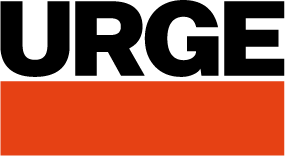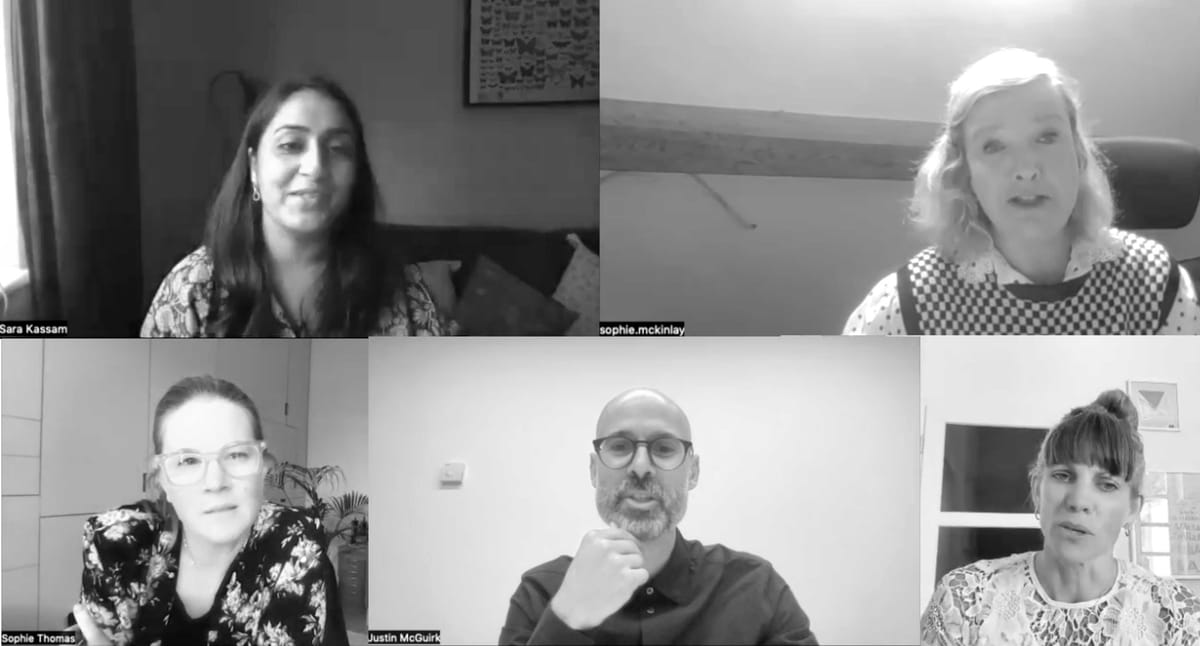
Clockwise from top left: Sara Kassam, Sophie McKinlay, Alexie Sommer, Justin McGuirk and Sophie Thomas for URGE-X
URGE-X is our platform for investigating paradigm-shifting thinking in culture, business and society to tackle the Climate Crisis. For our first session, we wanted to explore the approaches that museums and designers can take in order to not just meet Net Zero targets but lead new thinking and public engagement in this space.
In October last year, URGE worked with the Design Museum to conduct what is believed to be the first ever environmental audit of an exhibition. Working with the designers and curators of the Design Museum's Waste Age exhibition, URGE was able both to reduce the show’s carbon footprint and measure its impact.
Building on the lessons of the Waste Age project, the panel aimed to explored strategies for reducing the impact of museums, both in the design and build of temporary exhibitions and installations and in the operation of museums themselves. We also wanted to explore how museums can lead public debate and engagement in tackling the Climate Crisis.
Our panel consisted of Sara Kassam, sustainability advisor and former Sustainability Lead at the V&A, Justin McGuirk, Chief Curator at the Design Museum, Sophie McKinlay, Director of Programme, V&A Dundee and, from URGE, Sophie Thomas and Alexie Sommer.
The museum world has certainly not been inactive when it comes to the Climate Crisis. Industry bodies such as the National Museum Directors’ Council and groups including Museums for Climate Action and the Gallery Climate Coalition have done important work in terms of understanding how museums have a climate impact and establishing tools and best practice guides to reduce that. And we should recognise the ongoing work of non-profit Julie’s Bicycle in supporting that and galvanising the arts and culture community.
However, Sara Kassam told us that she believes the sector is ‘ten years behind’ higher education when it comes to systemic change and engaging staff, management and stakeholders in what that involves. Nonetheless, partly through some of the work mentioned above, she has seen a real momentum shift in the past two years. Now the challenge is less about awareness and more one of consolidation and amplification of the work that is already taking place in a way that enables staff to see how and where they can play a part.
People, Place and Programme
At the V&A, Sara broke her sustainability strategy down into People, Place and Programme. For the museum’s people, the focus was on helping them understand “how they could use their enthusiasm, their expertise and their knowledge” to have “the most impact, the most influence and where to direct their time and resources”, empowering and enabling people to take action.
Place looked at the museum’s buildings and their operation while Programme sought to maximise the storytelling power of museums to engage audiences around climate topics.
The importance of Data
In order to help people with directing their decisions to where they will have the best effect, data is key. This, as Alexie Sommer and Sophie Thomas pointed out, was one of the key reasons for doing the WasteAge audit. “We've been working in this space for 15 years, and there are a lot of good ideas, but there's very little data to back them up. And the one thing we have got data on is carbon, which is why carbon is a metric that we use to measure impact,” Alexie told us.
Measuring the carbon helped exhibition designers understand the consequences of their decisions and provides data to inform future choices. Data analysis should play a role in decision-making at concept stage and be available to internal curatorial and design teams.
As Sophie Thomas said, “the earlier you get that data, the more it starts to influence your decisions, as a curatorial team, as an exhibition designer”. Having genuine data helps dispel myths about where the biggest impacts are (for Waste Age, Zoom conversations contributed more than transport for example) and throws up unexpected imperatives, such as saving the 4,800 screws used in the build of the show for future use.
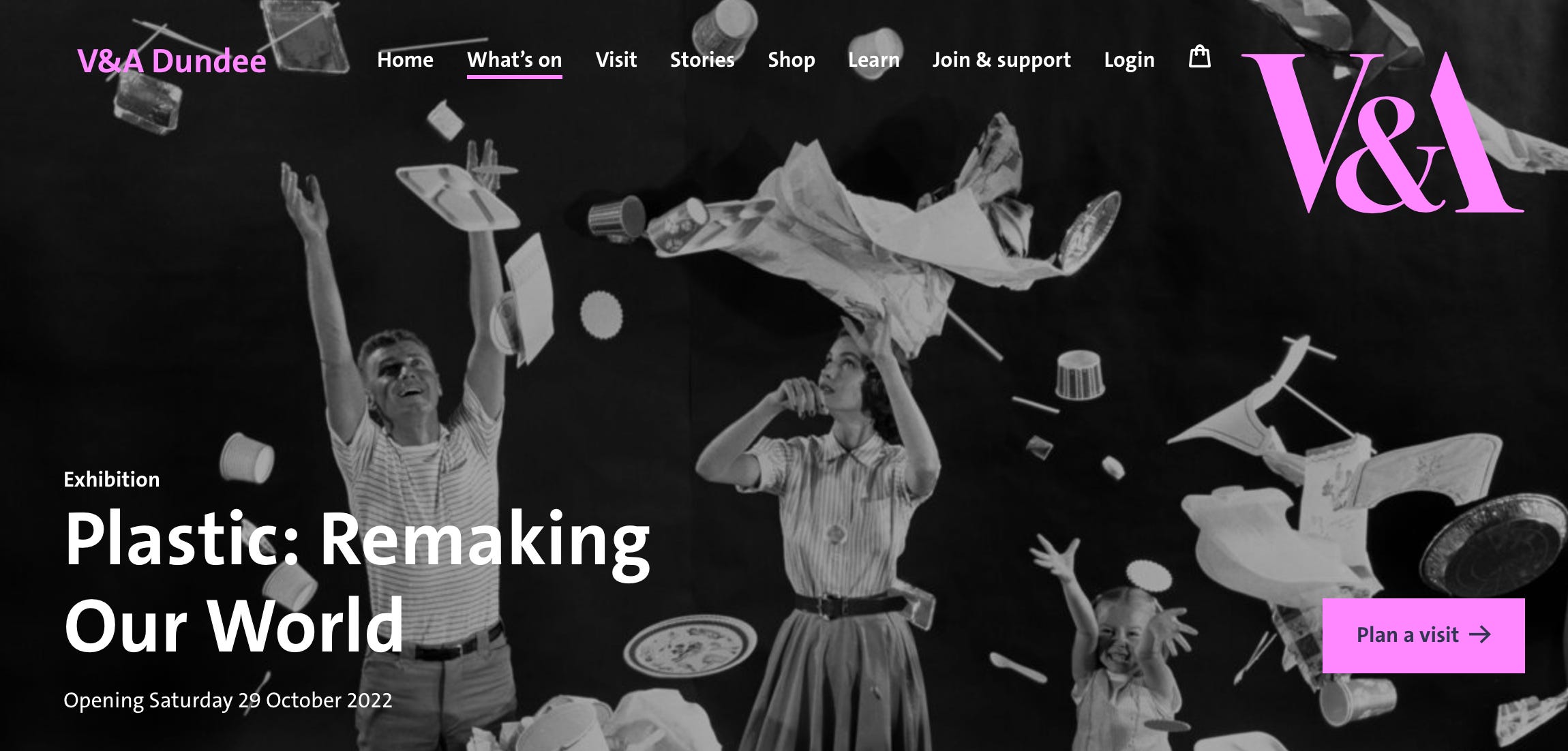
A manifesto for exhibitions
Sophie McKinlay told us that she also initiated an audit for V&A Dundee’s upcoming show on plastic, which Julie’s Bicycle carried out. The audit helped them understand where they are now, but also “what are the principles that we want to be sharing with all partners, or all designers and build contractors in realising our exhibitions moving forward? …It’s also been about training and education within the team, being aware of the personal agency that one has in the decisions that one makes, when considering the materiality of an exhibition, and the choices that one makes.”
This can the be turned into “a set of principles, a kind of manifesto really” for future shows.
Another such manifesto has been developed at the recent BIO27 Biennial of Design Ljubljana where Sophie Thomas told us she had been working with a group of designers and architects to produce a Guide to Sustainable Cultural Production (below), which is available to download from the Biennal’s site bio27.si.
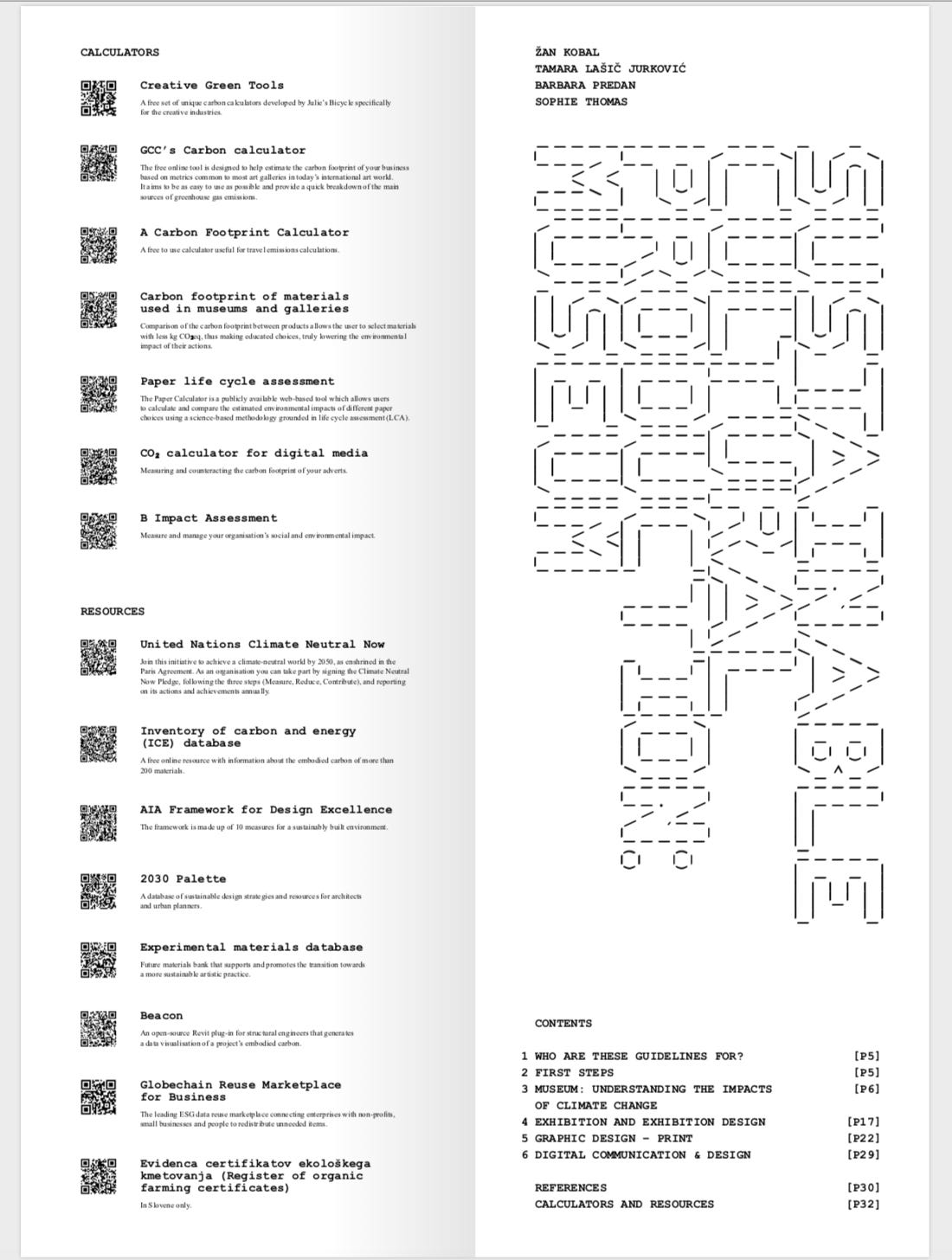
The barriers
What stops museums acting in a more sustainable way when it comes to exhibitions? “The barriers are really prosaic,” Justin McGuirk told us. “It’s time, small teams needing to do extra work in order to make their projects more sustainable, to find homes for materials afterwards. And another barrier is money.” He gave us two examples of how good intentions were frustrated by relatively minor issues. “Some of the materials from Waste Age were pledged to a small arts institution. At the last minute, they cancelled because they realised they'd have to pay for the transport and they didn't have the budget for that, but they cancelled so late that we had to put that stuff into a skip.” The other example was when the Design Museum though it could borrow mannequins for a fashion show from another institution rather than ordering new ones, “but the response was, ‘oh, no, we don't do that’. And I suspect it's not that they were trying to be unhelpful, it's just that that person was factoring in how much time it would take to lend nearly 100 mannequins and just realised it wasn't viable, perhaps. It's these kinds of small things which take extra work, and extra time and extra money.”
Sophie McKinlay said that the answer is to ensure that “sustainability just needs to be part of the core values of each project. And it just needs to be factored in, in terms of the schedule and so on”. The museum sector, she says, could also help itself by reviewing some of the accepted standards around object display and care. “Not to diminish those, but to maybe just reassess some of the decisions that we're currently making, and to really interrogate some of those decisions, because we take them as given when our conservation teams quite rightly say that work needs to be exhibited in a particular kind of environment. We are a design museum, so we should be able to solve these problems with a bit more efficiency.”
In order to help do just that, Sara Kassam told us that when she was at the V&A they tried to upskill the internal design team to help them understand the issues and to be better clients when commissioning external suppliers, challenging briefs from partners within the institution and helping the team to know where they can access data on carbon and how to use it to inform their work. Recent training on materials went beyond typical museum concerns around, for example, fire safety to consider sustainability credentials too, “Like is it produced locally? Where is it made? How far did it come?” And finally the team looked at introducing an element of reporting on impact into post-exhibition reviews, so that environmental impact is measured along with visitor numbers and revenue.
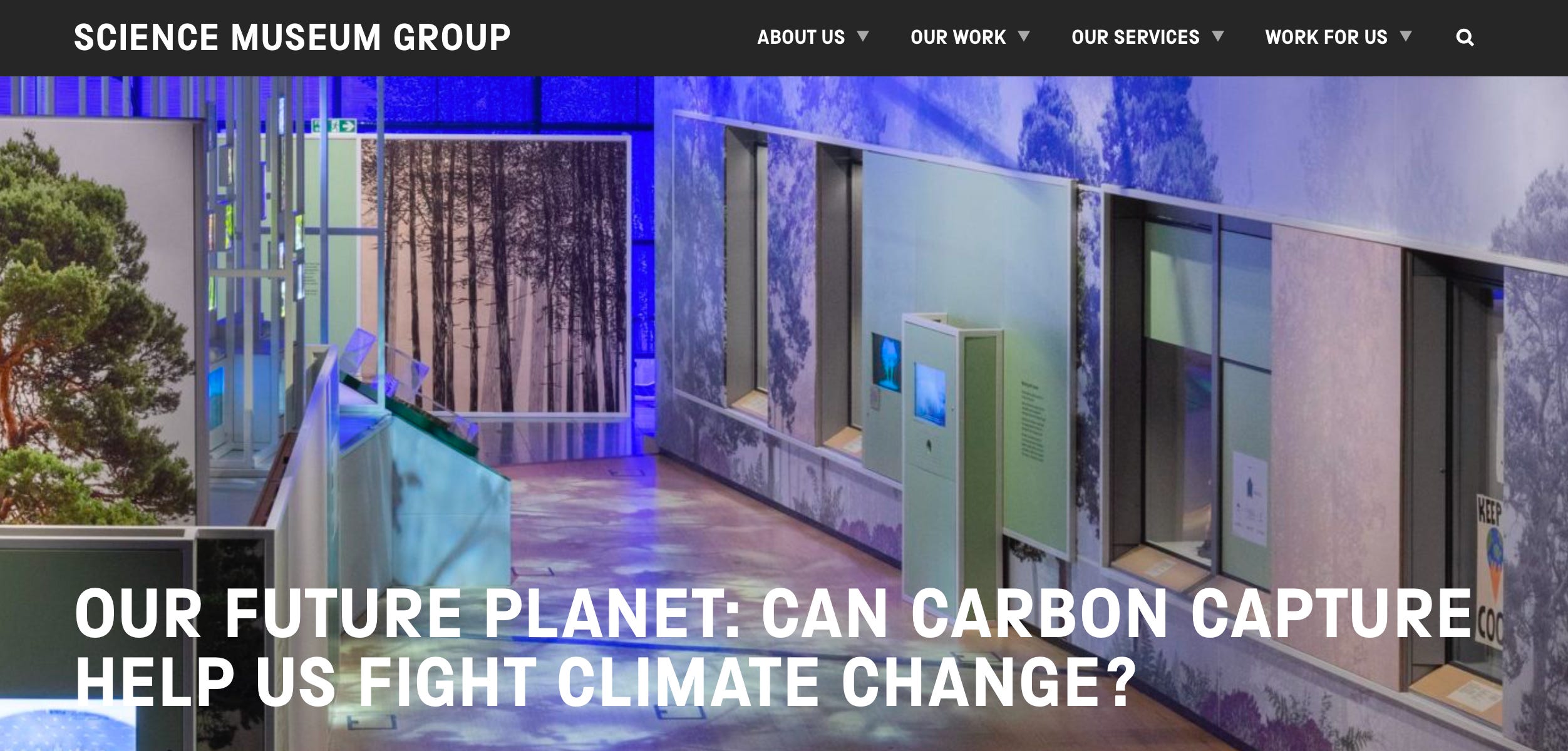
Reimagining the touring show
While operational changes can make a huge difference, we also challenged our panel to think bigger: what paradigm-shifting thinking could transform the sector? Many institutions derive significant revenue from hiring out so-called ‘turn key’ exhibitions, offered as a complete, packaged product for hire. New business models, however, are challenging this idea. The Science Museum, for example, has developed its Exhibition Blueprint Pack model whereby all the content and digital assets for a show can be downloaded and produced locally, saving transport costs and emissions as well as allowing the same show to run at multiple venues at once.
Sophie McKinlay suggested that a new approach to the touring show, could see just a core kit of key objects supplied by the originating museum. The receiving venue would then “have the opportunity to contextualise the exhibition for a local audience, and also use local build contractors, local designers, and really make it their own. I think that the notion of this monolithic touring show model is slipping away.”
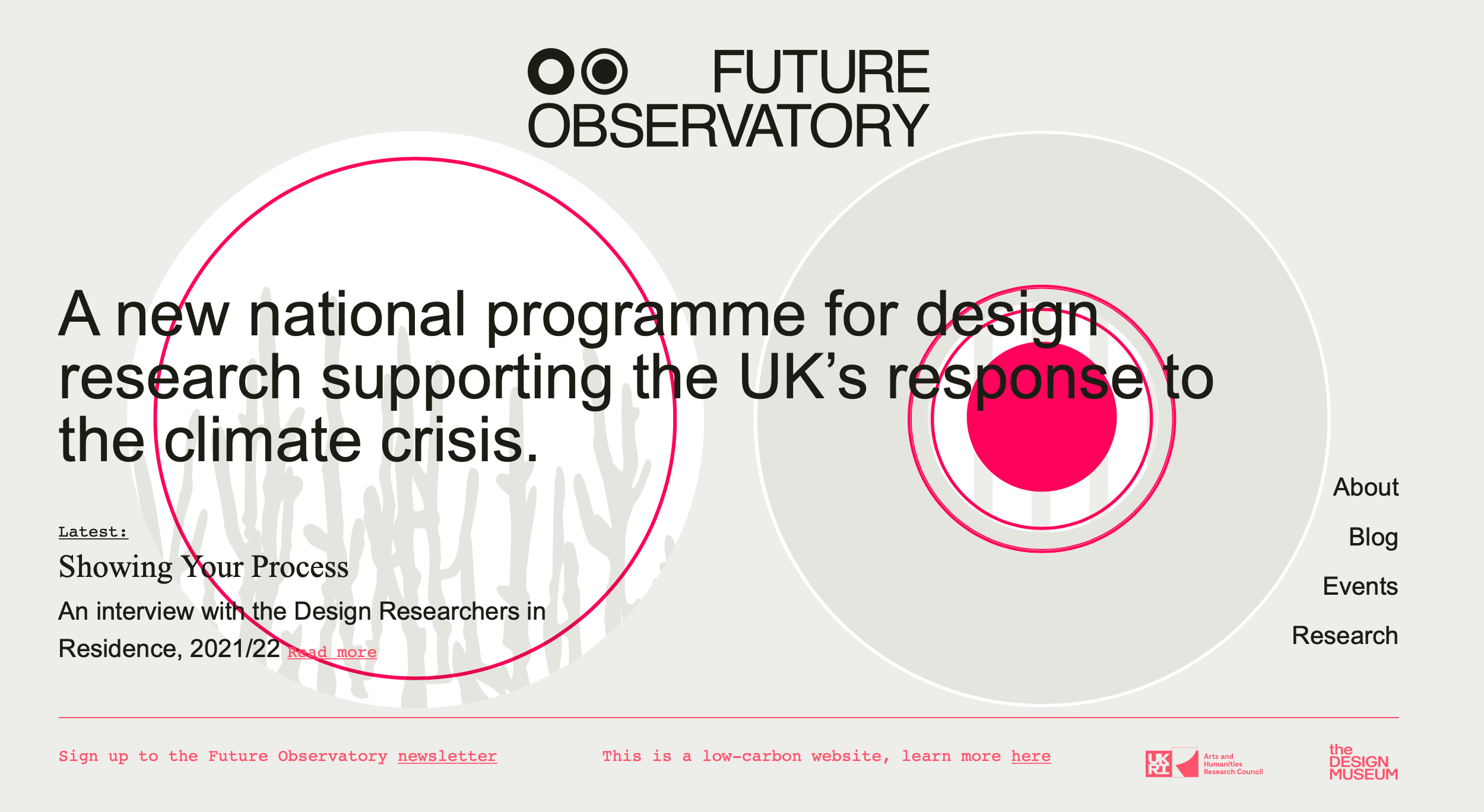
Reimagining the museum itself
Justin McGuirk was keen to move the debate on from exhibitions to the idea of the museum itself. He is Director of the newly-launched Future Observatory, “a new national programme for design research supporting the UK’s response to the climate crisis” based out of the Design Museum. “It really changes what a museum is, and what a museum can do,” he says. “We are institutions that are used to reflecting on the past and the present. And this is turning the museum into something that can help drive change in the future. It makes the museum a catalyst for change, as opposed to just raising awareness.”
And understanding that designers have agency
Finally, Sophie Thomas issued a rallying cry for designers - all designers. “The climate emergency, and all of the things around sustainability, to me are just systemic design challenges. The interesting thing about designers is that they can go deep into detail, and then they can come out and look at the bigger picture. And so we should all be collectively coming together. It's not just about the designers, but who you're connecting to – an anthropologist, a curator, a scientist, policymakers, all of these people, that's our design team effectively. I don't believe in this idea that we don't have agency or we don’t know where to start. We just need to put one foot in front of the other.”
For news of further URGE-X events, follow us on Twitter or on LinkedIn
